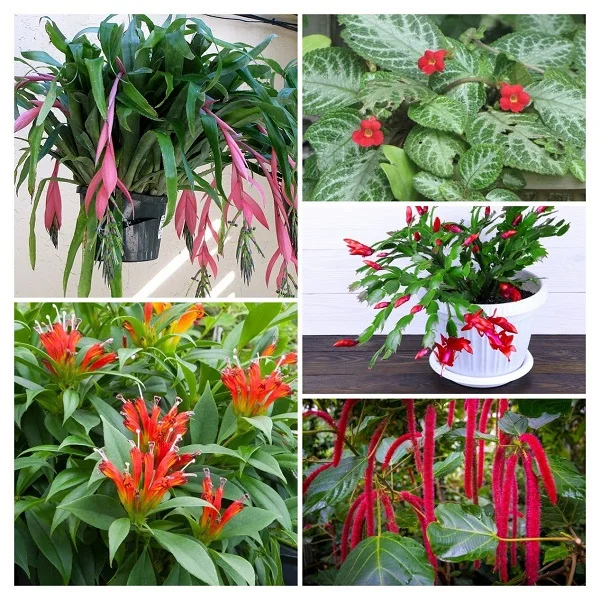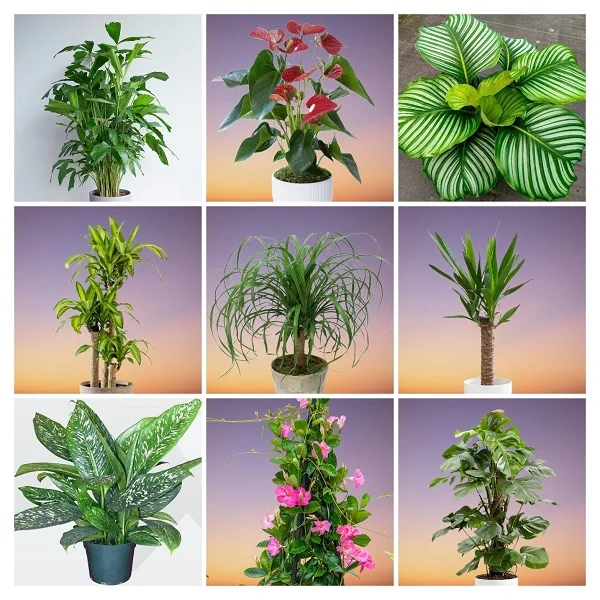African Lily (Agapanthus africanus) Indoor Care, Propagation, Problems and Solutions
Some links in this post may be affiliate links
AAgapanthus africanus (African Lily) flourishes in bright light with some direct sunlight, average warmth, moderate humidity and consistently moist, rich, well-drained soil coupled with fortnightly feeding in the growing season.
Agapanthus africanus also called Lily of the Nile is one of the popular flowering plants and bears large round heads of beautiful tubular flowers on long stalks which appear in succession through out the growing season.
Lily of the Nile bears strap-like leaves about 1 ft long and ball-like flower heads which are about 3-8 inches in diameter.
African Lily is a large plant which is propagated by means of the underground rhizomes and requires a large space to grow. The plant prefers to be pot-bound as it blooms best when pot-bound.
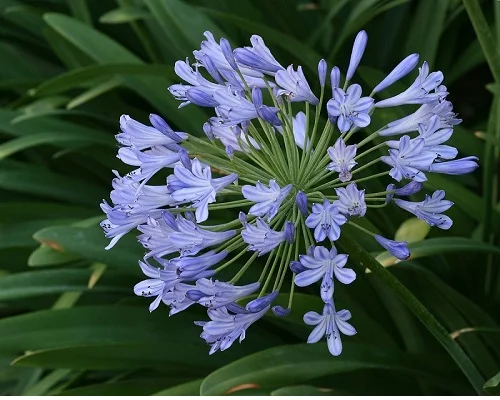
Botanical name: Agapanthus africanus
Family: Armaryllidaceae
Common names: African Lily, Lily of the Nile
Origin
Agapanthus africanus is native to the area of Cape of Good Hope in South Africa.
Size
African Lily is a fast-growing plant which grows to a height of 2-3 feet and about 2 feet wide. The strap-like leaves are about 1 ft long.
Varieties
The main flower color in African Lily is blue but there is a white-flowered cultivar, Albus. It also has varieties that are pink and violet.
Is Agapanthus africanus poisonous?
All parts of Agapanthus africanus are poisonous to both human and pets, especially the rhizome or root, leaves and sap. If ingested it may cause nausea vomiting, abdominal pain and diarrhoea, with severe ulceration of the mouth from the clear sticky sap.
Contact with the plant sap may cause a burning sensation, skin irritation and rashes. Keep your Lily of the Nile away from the reach of children and pets and always wear gloves when handling it.
Where to Buy
Are you looking to add African Lily to your collection? Check them out on Etsy (Link to Etsy).
How to Care for African Lily indoors
To care for African Lily indoors, provide bright light with 4-6 hours of direct sunlight, warmth of 16-270C, humidity of 50-55% and consistently moist, fertile, well-drained soil coupled with fortnightly feeding during the growing season.
Agapanthus africanus requires pruning to keep it neat, to minimize pests and diseases and to rejuvenate growth. Repotting is necessary only when the plant becomes extremely pot-bound as it blooms best when slightly root-bound. Keep reading for more on these growing conditions and how to achieve them.
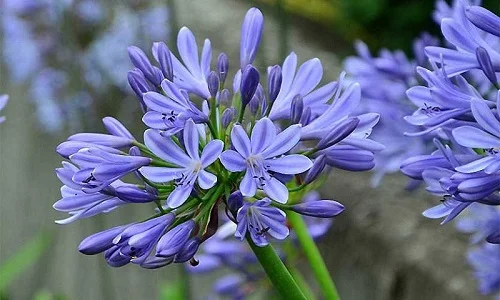
Watering
How often should I water an African Lily?
Water your African Lily thoroughly in spring and summer and allow the top 1-2 inches of soil to dry out between waterings. Keep the soil moist but avoid overwatering to prevent yellowing, rotting, leaf drop and lack of blooms.
Cut down on watering in fall and winter to maintain the soil slightly moist but do not let the soil dry out completely as it can lead to wilting, leaf drop and no flowers.
Use water that is at room temperature to prevent cold shock which can result in slowed growth and leaf drop. Avoid chlorinated water to prevent browning of leaf tips and edges; use rain water or filtered water.
Ascertain that the soil is free-draining and that the pot has a drainage hole to avoid getting soggy soil as it can lead to rotting and death of the plant.
Light Requirements
Does African Lily like sun or shade?
African Lily grows best in bright light with at least 4-6 hours of morning or late afternoon sunshine per day to promote flowering. Keep it away from hot midday sun to prevent scorching.
Under too little light, Agapanthus africanus will not bloom. Where the natural lighting is not sufficient you may grow the plant under a full spectrum grow light.
Regularly turn the pot to ensure that the Lily of the Nile receives light on all sides for even growth and prevent lopsided growth.
Temperature and Humidity
Average temperature of 16-270C is ideal for African Lily. Keep it away from sources of drafts as they cause sudden changes in temperatures which may result in stunted growth, leaf drop and lack of flowers.
Agapanthus africanus thrives in an moderate humidity of 50-55%. It has no need for extra humidity. Ensure that there is good air circulation to discourage fungal diseases.
Fertilizer
What is the best fertilizer for Agapanthus africanus?
Feed your Agapanthus africanus with a phosphorous-rich, water-soluble fertilizer every 2 weeks in spring and summer to promote a lush growth and boost flowering.
Minimize or stop feeding African Lily in fall and winter to prevent fertilizer burn as growth is reduced at this time.
Pruning & Grooming
How to prune African Lily?
Pruning African Lily involves removing dead blooms and leaves to maintain the plant neat as well as discourage pest and disease infestations.
In addition, cutback the stems at the base when they begin to shrivel to rejuvenate growth and also encourage a bushy, compact growth.
Occasionally clean the leaves by damp wiping with a soft cloth to get rid of dust as well as discourage pests and diseases infestations.
Potting Soil
The best potting soil for African Lily should be rich in organic matter and free-draining to prevent it from getting soggy while providing the required nutrients. Most multipurpose potting mixes are ideal for this plant.
Repotting
When is the best time to repot an African Lily?
Repot your African Lily at the beginning of the growing season (spring to early summer), only when the plant becomes extremely pot-bound. It blooms best when slightly pot-bound. Repotting every 2-3 years is adequate for this plant.
How to repot an African Lily?
- Select a pot one size larger than the current one. Ensure that the pot has a drainage hole and the soil is free-draining soil to avoid rotting. Check out these pots with drainage holes on Amazon.
- Carefully, slip the plant out of its pot, shake off the old potting mix and trim the dead roots with clean and sterilized scissors.
- Place the plant in the center of the new pot and refill with fresh free-draining potting mix.
- Thoroughly wet the soil until water comes out through the drainage hole and empty the saucer to prevent waterlogging.
- Put back the plant to its original display position and carry on with routine care.
African Lily Propagation
African Lily is easily propagated by plant division. The best time to divide Agapanthus africanus is at the beginning of the growing season (spring to early summer) when it is in active growth.
Propagating African Lily by plant division
- One day before division, thoroughly water the plant to make it easier to divide as well as hasten establishment.
- Carefully slip the plant out of its pot and with a clean, sharp pair of scissors divide the rhizome into sections while ensuring each section has adequate roots and some leaves.
- Select small pots which have a drainage hole to prevent the soil from getting soggy to avoid rotting. Ensure the pots are about 1 inch wider than the base ofrhizome sections.
- Fill the pots one third way with free-draining soil and moisten it slightly.
- Place each section in the center of the pot, continue to fill the pot while firming the soil around the roots.
- Place the pots in a warm, well-lit place away from direct sunlight to avoid sunscorching.
- Maintain the soil moist through out until the new plants are well established after which you can begin routine care.
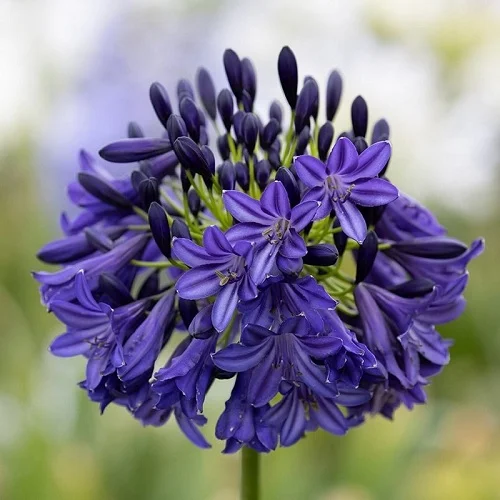
Agapanthus africanus Problems & Solutions
African Lily problems are yellow leaves, lack of blooms, droopy wilting leaves, diseases and pests. Keep reading for more on these problems and how to fix them.
Yellow leaves
Why do Agapanthus africanus turn yellow?
The main causes of yellow leaves on Agapanthus africanus are too little light, inconsistent watering, soggy soil, nutrient deficiency, temperature stress, direct sunlight and aging.
How to fix it
Too little light: Move the plant to a brighter spot where it will receive bright light with at least 4-6 hours of morning or late afternoon sunshine per day or instal a grow light if the natural light is not enough.
Inconsistent watering: Do not water on a schedule. Water only when the top 1-2 inches of soil dry out.
Soggy soil: Use a well-draining soil and a pot with a drainage hole.
Nutrients deficiency: Apply a phosphorous-rich, water-soluble fertilizer every 2 weeks in spring and summer.
Temperature stress: Keep the plant away from drafts coming from hot surfaces, hot air vents, AC units, windy doors among others.
Direct sunlight: Keep the plant away from hot midday sun or use a light curtain to protect it from the sunshine.
Aging: This is a natural process; as the plant matures the lower leaves turn yellow; cut away the yellow leaf at the base to keep the plant neat and tidy.
Lack of blooms
Why is my African Lily not flowering?
Your African Lily may not to flower due to too little light, nutrients deficiency, inconsistent watering, too frequent repotting or temperature stress.
How to fix it
Too little light: Position the plant in bright light with at least 4-6 hours of sunshine per day or instal a grow light where natural lighting is not adequate.
Nutrients deficiency: Fertilize with a phosphorous-rich, water-soluble fertilizer every 2 weeks in spring and summer to promote flowering.
Inconsistent watering: Water when the top 1-2 inches feel dry. Do not water on a schedule.
Too frequent repotting: Repot the plant only when it is extremely root-bound as it blooms best when pot-bound.
Temperature stress: Keep the plant away from sources of drafts like AC units, hot air vents, windy doors and windows among others.
Wilting and droopy leaves
Wilting and droopy leaves on African Lily are caused by underwatering and temperature stress.
How to fix it
Underwatering: Maintain the soil moist in spring and summer and slightly moist in fall and winter. Never allow the soil to dry out completely.
Temperature stress: Keep the plant away from drafts emanating from AC units, hot air vents, windy doors and windows among others.
Diseases
African Lily is prone to root-rot disease which is a fungal disease that is prevalent in soggy soil due to poor soil drainage.
How to fix it
- Slip the plant out of its pot, wash off the soil and inspect the roots.
- Brown-black, mushy roots indicate root-rot; cut them away. In addition, cut away any stems showing any signs of rot.
- Disinfect the remaining roots and the entire plant with a copper-based fungicidal solution as recommended by the manufacturer.
- Disinfect the pot with the fungicidal solution or use a fresh pot to repot the plant in fresh potting soil.
- Ensure that the pot has a drainage hole and the soil is well-draining to prevent waterlogging.
- Water the plant with the fungicidal solution and place it in a warm, brightly-lit spot.
- Do not water the plant again until new growth appears and avoid overwatering and soggy soil thereafter.
Pests
Common pests on African Lily are mealybugs and aphids which are prevalent in dry air conditions.
How to fix it
- Isolate the affected plant to prevent spread to the other plants.
- Treat the plant with neem oil or insecticidal soap. Ensure to follow the instructions on the label.
- Maintain the plant well pruned to discourage the pests.
- Set the pot on a wet pebble tray or group the plants together to raise humidity to minimize the pests infestations.
You liked it? Share on social media.
Related Content
Amazon Associates Disclosure
Homeplantsguide.com is a participant in the Amazon Services LLC Associates Program, an affiliate advertising program designed to provide a means for sites to earn advertising fees by advertising and linking to amazon.com.



